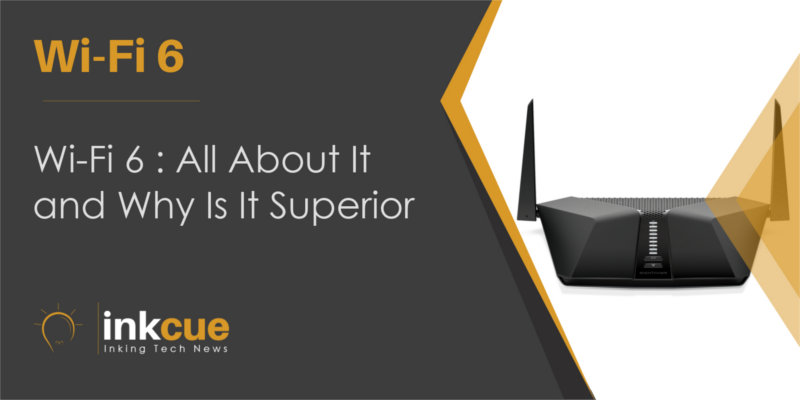
All of us are familiar with Wi-Fi. We have it in our homes, we find it in offices, airports, railway stations, stadiums and various other places. Now, if a person is curious enough they might have noticed a difference between the access points used in homes and crowded places outdoor. At crowded places, the number of devices can shoot up. Wi-Fi 6 is here to improve the overall router performance.
Wi-Fi 6 provides major improvements and new technologies with it. Let us find out in detail what is Wi-Fi 6 and the new features/improvements it brings.
What is Wi-Fi 6?
According to the Wi-Fi Alliance, Wi-Fi 6 or Wi-Fi CERTIFIED 6™ is the industry certification program based on the IEEE 802.11ax. The 802.11ax is one of the standards under the IEEE 802 family which deals with Local Area Networks and Metropolitan Area Networks.
We are familiar with the 2.4GHz operational frequency which is widely used. Operational frequency of 5GHz is also becoming increasingly common in daily use with the introduction of dual-band domestic/indoor routers. New devices with support for both frequencies has aided in this process. WiFi 6 introduces a new operational frequency of 6GHz. This new operational frequency along with other new and better technologies makes this new standard superior to others.
With the AX comes increased capacity, efficiency, coverage, performance, security and more. These parameters are of utmost importance as being connected is getting increasingly important in people’s day-to-day life. Let us have a look into them.
Additional Information
- Discover Wi-Fi 6 (Wi-Fi Alliance)
- IEEE 802.11ax (Wikipedia)
New Technologies and Improvements
With increasing needs of user, technological advancements and innovations must be made to fulfill those needs. There are multiple new technologies incorporated with the Wi-Fi 6 like OFDMA, MU-MIMO, TWT etc. Let us know more about these in detail and what do they offer.
OFDMA
Orthogonal Frequency Division Multiple Access (OFDMA) is introduced in Wi-Fi 6 to minimize data loss while transmission of data thus increasing the network efficiency. People must have also noticed a significant deterioration in latency under high demand or when number of connected devices increase. OFDMA helps in improving latency for both Uplink and Downlink transmission during high demands.
Additional Information
- Why is OFDMA a Magical Feature in the 802.11ax Standard? (Network World)
- Channel Access Method (Wikipedia)
MU-MIMO
Multiple User – Multiple Input, Multiple Output (MU-MIMO) enables increased downlink data which helps in increasing the number of devices that the access points can handle simultaneously.
TWT
Target Wake Time (TWT) aims at improving network efficiency and reduce power consumption of battery powered devices.
Read More: CTS 164: 802.11ax Target Wake Time (Clear To Send)
1024 QAM
1024 Quadrature Amplitude Modulation mode helps in increasing the data transmission or throughput using the same bandwidth. It helps in bandwidth-intensive uses by encoding more data without increasing the bandwidth required.
Read More: QAM Is Rising: 1024QAM And Beyond (Microwaves&RF)
WPA3
Multitude of people think twice before connecting connecting to public Wi-Fi because of security concerns. Public Wi-Fi spots are notorious for theft of confidential/personal data. The WPA2 protocol used in 802.11ac has been around for many years and although it has served us well, it has gradually become outdated and can be easily manipulated.
With the next generation of 802.11 comes the next generation of WPA i.e. WPA3. The list of new security enhancements in WPA3 include:
- Individualized Data Encryption.
- Protection against Brute-Force attacks.
- Increased security for devices without screens such as smart home devices.
- Support for 192 bit encryption for higher security requirements.
It is childish to assume that WPA3 will make the network perfectly safe but with the new security measures, spying on devices connected on the same network will become a whole lot difficult. These measures make public Wi-Fi spots more accessible for everyone.
It is also important to check if the connection is WPA3 protected before connecting. Wi-Fi 6 is still relatively new in the market and device manufacturers are gradually integrating WPA3 protocol in their products. One must always be careful while connecting to public Wi-Fi.
Additional Information
Drawbacks
We have seen that Wi-Fi 6 brings a host of improvements as compared to 802.11ac. But as the saying goes, nothing is perfect, and Wi-Fi 6 is no exception. It does get almost all the things right with a couple of exceptions : coverage area and price.
There is a rule of electromagnetic waves that as the frequency of a wave increases its penetration power decreases. People using dual-band routers must have experienced significantly inferior performance on 5GHz band as compared to 2.4GHz band when there are walls or obstructions between them and the router. As Wi-Fi 6 introduces an even higher frequency band of 6GHz, laws of physics cannot be bent and coverage area takes a hit.
Wi-Fi 6 also comes with lot of new and better technologies to improve performance in every aspect. And to achieve this, the hardware of the Wi-Fi 6 enables routers are more sensitive, complex and high-tech than ever. This, in turn, significantly increase the price of Wi-Fi 6 enabled routers. It is difficult to recommend a Wi-Fi 6 enabled router for domestic use. Although, if someone has special needs such as gaming or have high bandwidth demands regularly or simply have cash to spare can opt for one.
We will be coming up with a post on best Wi-Fi 6 enabled routers soon. Stay tuned!
Read More: Want to improve the speed of your PC as well? Upgrade from traditional Mechanical Hard Drive to SSD. Check out our complete guide on the best SSD for your PC.
MORE FROM INKCUE
Conclusion
We have now witnessed all about Wi-Fi 6. We went through the new technologies introduced and the advantages and drawbacks they bring. We have also learnt why it was necessary. Sufficient additional links have also been provided for readers as there is always something new to know in the world technology. Maximum effort has been put in to provide accurate, useful and complete information to the reader.
Feel free to express your thoughts or ask anything regarding the article in the comments section below.
Comments that are personal, abusive or irrelevant won’t be published. Do write complete sentences without abbreviations. Genuine email ID and name is required to ensure that your comment is published.
Thank you for reading ?

Rohan K. Prasad
Rohan K. Prasad is the Editor in Chief at Inkcue. He is an engineer with specialization in Electronics & Communication. He is an admirer of modern technology and covers electronic devices of all types.
Rohan K. Prasad is an author at Tech Inkcue. He is an engineer with specialization in Electronics & Communication. He is an admirer of modern technology and covers electronic machines of any type.

